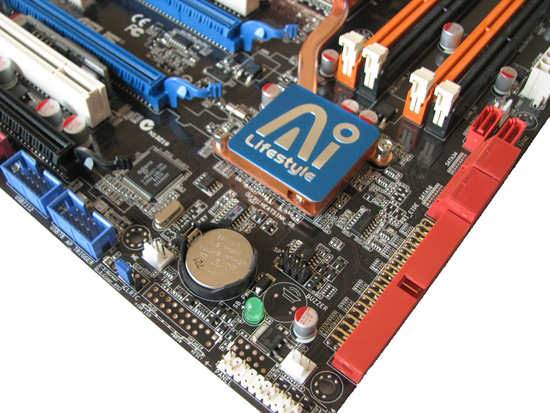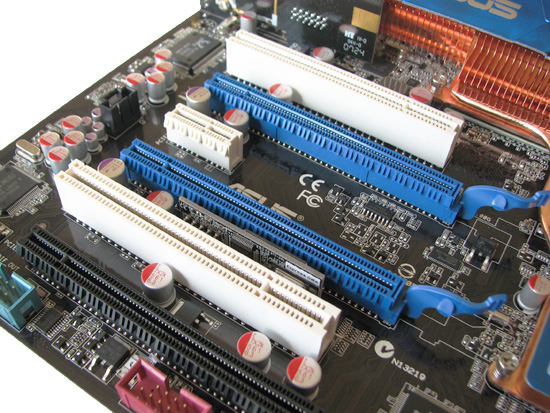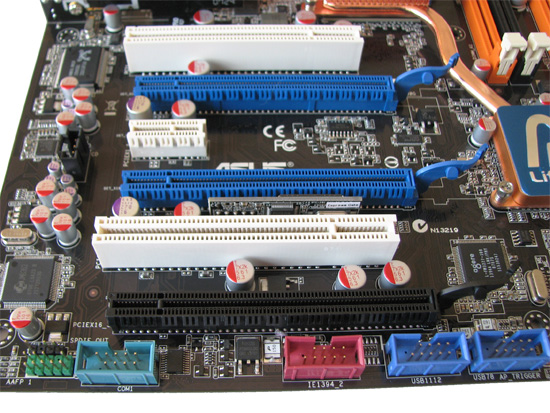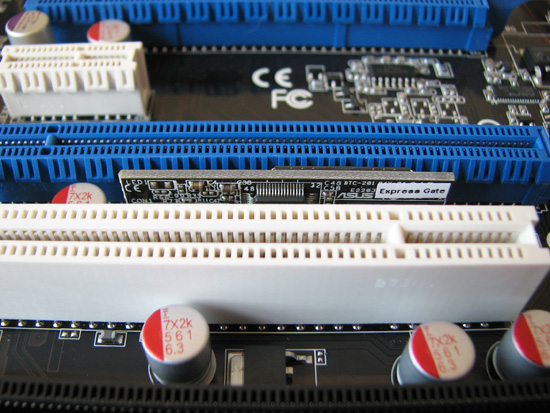ASUS P5E3 Premium: One to Rule them All…
by Kris Boughton on February 20, 2008 12:15 AM EST- Posted in
- Motherboards
Board Layout and Features (Continued)

The hefty copper heatsink located atop the Southbridge is more than acceptable when it comes to controlling the temperature of the low-power ICH9R chipset; the Ai LifeStyle logo adorns the cover. As we mentioned earlier, the screw-mount system is great at allowing for maximum mounting pressure.
The battery is installed in an accessible location and the jumper seen below it can be used to reset the RTC (real time clock) without the need to remove the battery. The clear CMOS reset jumper is located right below the fan header, although the board is very capable of gracefully recovering should an overclock fail.
The single green LED is a power-on indicator, and the speaker pad seen just above it is empty as always - which makes us wonder why ASUS continues to design these into their boards but then never populates the area with a cheap buzzer. If not a cheap buzzer, then at least install the power on/off and reset buttons seen on the R.O.G. series of boards. We can also see two of the six fan headers, the other two being located along the middle horizontal axis of the board and the final two near the top.

All six of the SATA 3.0Gbps ports seen here connect to the Intel ICH9R. The two vertical headers are ports 0 and 1, the other four 90-degree headers are ports 2 thorough 5. The single PATA header comes courtesy of a JMicron JMB363 controller, which also provides the eSATA ports located on the I/O panel.
The two dark blue header shrouds are for connecting extra USB 2.0/1.1 headers to the board. The red header is another IEEE 1394a port (the first is located on the I/O panel), controlled by the Agere chip placed above the battery. The light green header to the far back is for connecting a COM port extender cable, for those that still need one.


The X48 chipset offers two full x16 PCI-Express 2.0 expansion slots (blue) supporting CrossFire technology. The third PCI-Express x16 expansion slot (black) is PCI-E 1.x compatible and is only capable of training either x4 or x1 link speeds even though it can seat up to x16 cards mechanically. With no word yet if NVIDIA's recent acquisition of AGEIA might allow the use of a third video graphics card (such as the single-slot 8800GT), for now this slot may not need a GPU. Seeing as how NVIDIA has always been rather selective when it comes to allowing competitors the use of any of their multi-GPU technologies we can only imagine the answer is negative, Ghost Rider (the pattern is full). Perhaps NVIDIA (or AMD or Intel) will prove us wrong.
As with most DDR3 motherboards, the memory slots are further from the top of the board, locating them closer to the MCH. As a result, there is just barely enough room to install two graphics cards with dual-slot coolers, and doing so renders the only PCI-E x1 slot completely inaccessible. Unlike the P5E3 Deluxe, which features two PCI-E x1 slots, the Premium version lacks the upper slot due to the redesign of the MCH power regulation circuit. Perhaps a better decision would have been to locate one of the standard PCI slots here; that way the single PCI-E x1 slot and one of the two PCI slots would be available when running CrossFire with full-sized card coolers. In any case, we can see the importance of carefully planning for any future system expansion.

ASUS' proprietary WiFi-AP@n (is that the best name they could come up with?) expansion card brings full draft-N wireless functionality to the motherboard, a rather considerable bonus considering the cost of add-in cards. The unit connects via a hardwired USB interface, which is why the dual-homed card (two antennas) reduces the motherboard's USB capabilities from the standard 12 ports offered by the ICH9(R) to just 10.

ASUS' Express Gate offers a unique quick-boot environment that allows you to almost instantly access commonly used functions like web browsing or communications applications without loading a traditional OS (operating system). We found the need to increase the selection timeout due to the long initialization time of our graphics card, without which we would usually miss the full screen logo display and our chance to invoke the option.
In our opinion though, Express Gate has one major flaw: while the included WiFi-AP@n connection can be used in this environment, it is only able to connect to WEP-encrypted networks and not the newer and much more secure WPA/WPA2 networks that should be used today. Not wanting to downgrade our network from WPA2 to WEP, we had to abandon hope of making normal use of this feature for now. However, it will do in a pinch in case you need to connect to the Internet for a BIOS update, driver download, or a quick check of the weather. Those that connect their system via Ethernet to a switch or router should not have any problems, as either LAN port can function in place of the wireless connection.










32 Comments
View All Comments
ArthurCanada - Thursday, October 2, 2008 - link
Indeed folks. This is the most advanced and powerful board I have ever installed in a computer. I am running Vista Ultimate 64 bit and pushing my E8500 to 4 Ghz per core, much like in the testing. I can't begin to tell you how fast this motherboard with the E8500 is.For overclockers ... this is the board they have been waiting for. Period!
Arthur
Canada
drnick79 - Tuesday, April 1, 2008 - link
HelloI purchased this board with 2x1GB sticks of OCZ DDR3 1800 memory to use with my e8400 CPU (which I can get stable to at least 4050mhz on other mobos). What RAM did you use for this testing? I can't even come close to running stable at the settings you have listed, nor can I score any higher than about 11,500MB/sec read and 46ns with everest benchmark, and the settings I used to achieve those values are very unstable. And 1N memory settings??? This board won't even post if I set the memory to 1N running the memory over 1333mhz.
Just wondering if you could share the RAM brand you used along with your motherboard and RAM voltage settings to achieve such a feat.
Thanks,
Nick
HotBBQ - Monday, February 25, 2008 - link
"With an estimated retail price of around $299, there is a lot of value in the purchase of the P5E3 Premium for those looking at a high-end motherboard to use in the coming years."Where did the $299 come from? The X38 version of this board comes it at $340.
fabz - Saturday, February 23, 2008 - link
HiGreat review! I have been reading alot here att anandtech and generally all over the web preparing my first ever pc-build. Intel seem to be the way to go.
But,
have a look at the link posted below:
http://www.hardware.info/nl-NL/productdb/bGRkapiTm...">http://www.hardware.info/nl-NL/productdb/bGRkapiTm...
The DDR3 power circuit is different to the one here att anandtech. Still it claims to be the same board. At least so it seems to me. A couple of other sites have the same pics with different power circuits.
Are there different versions of the P5E3 PREMIUM/WIFI-AP@N in circulation? If so, how do i tell them apart before buying?
/Fabricio@cold, dark winter-sweden.
Aivas47a - Friday, February 22, 2008 - link
The one request I've had for Asus lately is to provide greater flexibility for fine-tuning of GTL reference voltages, as this is key especially for quad core overclocking. I'm delighted that Asus has apparently listened and responded.KainAT - Thursday, February 21, 2008 - link
Hi Kris. Very nice view for the mobo.As you have been practicing and analizing a lot on how doe sthe GTL reference voltage works, which settings for CPU and NB on GTL did you used for 550 FSB?
Also, which voltage should you consider to be the max for 24/7 situations? Around 1.4v?
If we had to do an analogy, between conroe and Wolfdale, when Conroe max voltage for 24/7 was around 1.5-1.6volts, on that time, being 1.3v the stock aprox. Now, with Wolfdale, 1.125v is about the common VID, so, which would be the voltage limit for 24/7?
Thanks on advise.
Kain
PolymerTim - Wednesday, February 20, 2008 - link
Maybe I missed the system specs. I can see the proc in the CPU-z shots, but I'm really curious what RAM you used for this test. Even though I know the MB is critical for getting this kind of performance out of the RAM, not mentioning which one you use seems to imply that you can get these results with any decent DDR3 RAM. Is that so?Thanks very much for the article. I very much appreciate reading a well crafted piece like this with lots of insight.
Xvys - Wednesday, February 20, 2008 - link
While this looks like a nice m/b, I am not as astounded by the memory performance as the writer of the article. On my Asus P5K-D, I acheived 44.5ns latency and memory read of 11,250...with only 2/3rds of the memory bus of the tested board. I am sure I could improve on that figure a fair bit if I was optimized the speed and timings for that purpose.AllanLim - Wednesday, February 20, 2008 - link
Yes, the X48 looks impressive as it should, but let's not forget this is NOT a retail sample. I just think it's misleading and premature to claim "To rule them all" when we haven't even looked at other X48 mobos.kjboughton - Wednesday, February 20, 2008 - link
Hi, to date we have reviewed the following Intel X48 boards: Gigabyte GA-X48T-DQ6, ASUS R.O.G. Rampage Formula, MSI X48 Platinum and ASUS P5E3 Premium (with the possibility of more to come). Thank you.